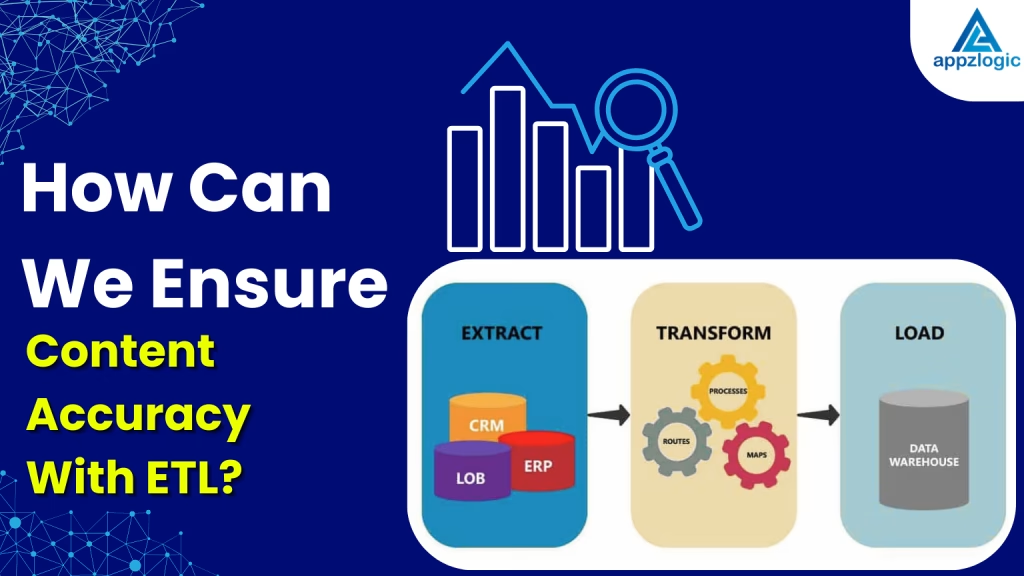
How Can We Ensure Content Accuracy With ETL?
ETL stands for Extract, Transform, Load. It is a process which is used in data management to collect information about data from different sources, change it into a useful format, and then move it to a storage system like a database or data warehouse. ETL helps businesses make sense of large amounts of data by cleaning and organizing it. One of the most important goals in ETL is to ensure that the data is accurate. If the data is not correct, business decisions based on it can lead to serious problems. That is why maintaining content accuracy in ETL is crucial. So, organizations can validate their data, maintain its quality, and ensure its integrity.
Why Content Accuracy Matters in ETL

Content accuracy means that the information we handle through ETL is complete, correct, and trustworthy. For example, imagine a company is using ETL technology to collect sales data. If the data is wrong, it might show fewer sales than occurred. This could lead to poor planning and lost revenue. Accurate content ensures that decision-makers can trust the data they see. It also helps in building reliable reports, dashboards, and forecasts. In industries like finance, healthcare, and logistics, even small errors can have a big impact. That is why companies must first understand business needs to design ETL processes that support accurate outcomes.
Step 1: Accurate Extraction of Data
The first step in ETL Software Testing is data extraction. To ensure accuracy here, we must connect to reliable data sources and use proper extraction methods. Sometimes, data sources are not always stable, or the structure may change over time. Using automated monitoring tools can help track these changes. Also, creating backups before extraction ensures that data is not lost. Checking logs during extraction is another useful way to catch any missing or corrupted data early in the process. Extraction, transformation and loading processes are a must for ETL.
Step 2: Clean and Reliable Transformation
Transformation is the step where raw data is changed into a usable format. This stage is often the most complex and the most prone to errors. To keep content accurate, businesses must define clear rules for transformation. For example, dates should be in the same format, duplicates should be removed, and checking for missing values and setting rules for handling them is essential. Use of data validation rules and business logic during transformation ensures that the final data matches expectations.
Step 3: Careful Loading into Target Systems
Once data is transformed, it is loaded into a target system like a data warehouse. Here, it is important to make sure that data is not lost, duplicated, or wrongly mapped. Use of integrity checks, such as comparing row counts and validating key fields, is essential. It is also good practice to test the loading process on a small dataset before applying it to the full data. This helps catch any potential issues early. Proper error handling and logging also support maintaining accuracy in this step, especially when reconciling source and target data, verifying data integrity, and assessing transformation logic.
Implementing Data Quality Checks

To ensure data accuracy throughout the ETL pipeline, data quality checks are very helpful. These checks include completeness, uniqueness, consistency, and validity. For instance, you can set rules that customer IDs must always be unique, or that dates must follow a certain format. Automation tools can perform these checks regularly and alert you if there is a problem. Ultimately, these steps help validate their data, maintain its quality, and ensure its integrity. Specialized tools like Datagaps ETL Validator and Airbyte can streamline the validation process and ensure consistent validation across the ETL pipeline and etl developer ensures this.
Using Metadata for Better Accuracy
Metadata is information about your data, such as where it came from, what type it is, and how it has been changed. Managing metadata properly can improve content accuracy. With metadata, you can track the flow of data and understand its context. This helps identify problems when they happen and correct them quickly. Many ETL tools now come with built-in metadata management features that make this task easier. This added visibility into the ETL process leads to better control and fewer errors.
Monitoring and Logging for Accuracy
Ongoing monitoring is important for keeping your ETL process healthy and accurate. You should set up automated systems that log each step of the ETL process. These logs can show you where something went wrong and how to fix it. Alerts and notifications also help by warning you if there is an issue in real- time. Over time, analyzing these logs can show trends and recurring issues, which can be fixed for better accuracy in the future.
Testing and Validation Techniques

Before going live with your ETL process, it is important to test it thoroughly. ETL testing is crucial for ensuring data accuracy. Testing should include unit tests for small parts of the process and end-to-end tests for the whole pipeline. You can also validate the output by comparing it with source data or expected results. Test cases should cover both normal and edge cases to make sure the system can handle unexpected data. Regular testing, even after the system is in use, ensures continued content accuracy as your data and systems evolve. For example: quality control publishing needs ETL validation. Regular testing, even after the system is in use, ensures continued content accuracy as your data and systems evolve.
Automation and Tools for Better Accuracy
There are many modern ETL tools that come with built-in features to help maintain data accuracy. Tools like Talend, Informatica, Apache NiFi, and Microsoft SSIS offer drag-and-drop interfaces, error handling, and real-time validation. Automation reduces human errors, speeds up the process, and ensures consistency. Machine learning and AI are also being used in advanced ETL tools to detect anomalies and improve accuracy even further. Choosing the right tool for your business needs can make a big difference when trying to validate their data, maintain its quality, and ensure its integrity.
Read more about: How Automation Testing with AI Improves Speed, Accuracy & ROI in QA
Regular Audits And Documentation
Conducting regular audits of your ETL process ensures that everything is running as expected. These audits can find hidden problems that might not be caught by automated systems. It is also important to maintain good documentation of your ETL workflows, rules, and data definitions. This helps new team members understand the system and makes troubleshooting easier.
Conclusion:
Ensuring content accuracy in ETL is not a one-time task as it is an ongoing process. From extraction to loading, every step must be carefully designed, monitored, and tested. By following best practices and investing in the right tools and people, any business can achieve reliable and accurate ETL pipelines that validate their data, maintain its quality, and ensure its integrity.
If you want ETL solutions for your business, contact us today as we are the best ETL Testing provider for U.S. data platforms and across the globe.
Frequently Asked Questions
Accurate data ensures better decisions and avoids costly mistakes.
Use rules and validation steps to detect and handle missing values.
They verify data completeness, uniqueness, consistency, and validity.
Use integrity checks and test with small data sets first.
Regularly, especially when data sources or business rules change.


